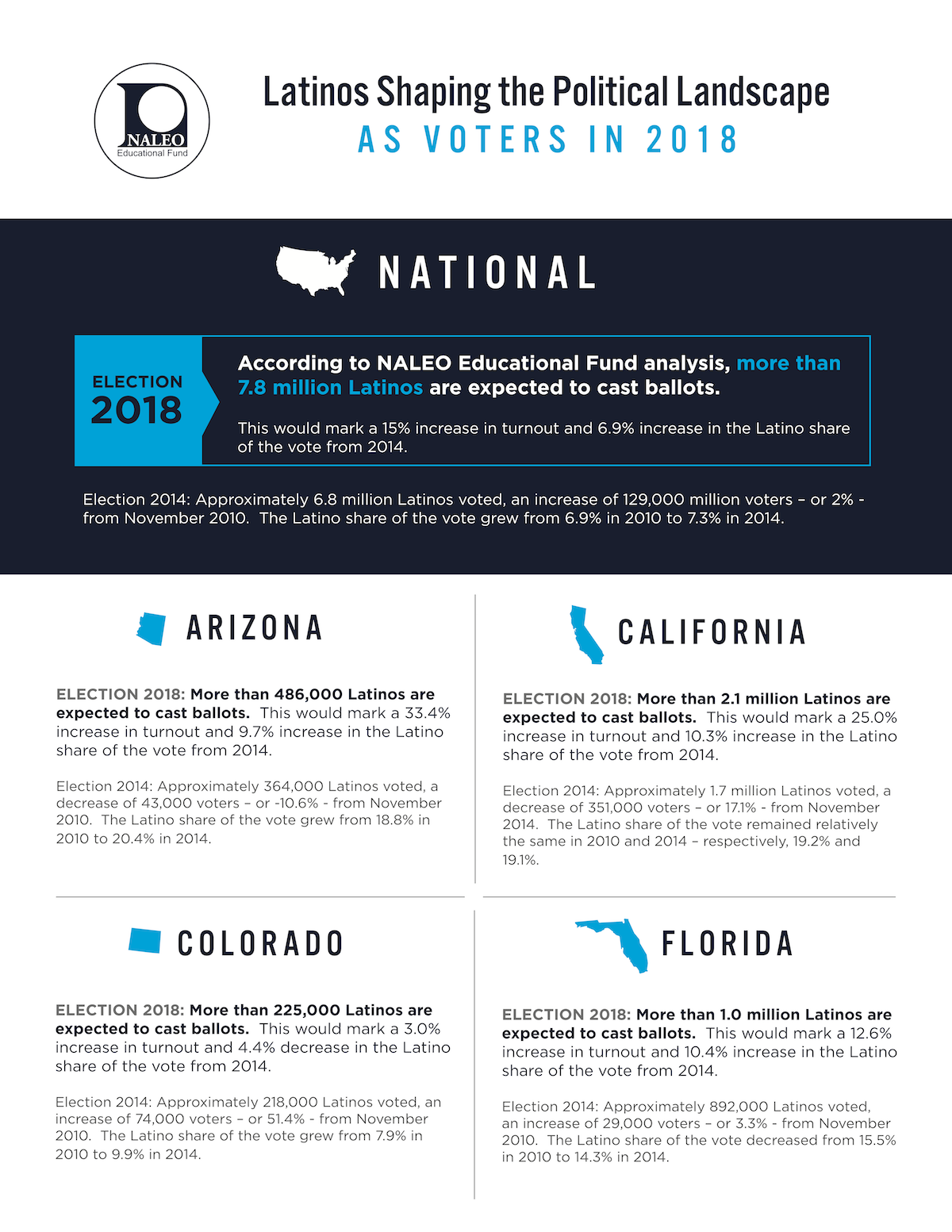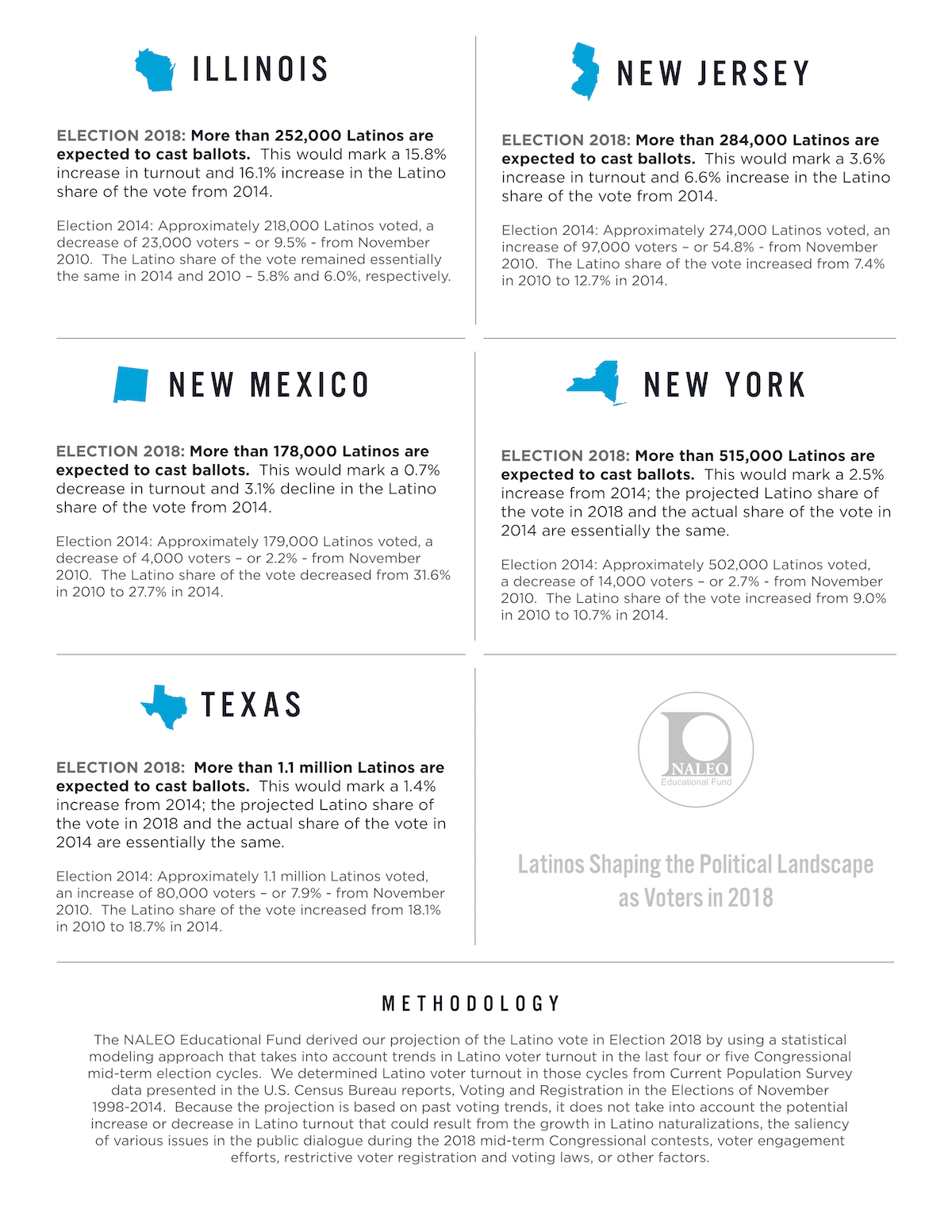WASHINGTON — Less than two weeks before Latino voters head to the polls, the National Association of Latino Elected and Appointed Officials (NALEO) Educational Fund released its projections for Latino turnout in key states and nationwide, as well as other critical election analysis during a briefing held at the National Press Club today.
According to NALEO Educational Fund analysis, more than 7.8 million Latinos are expected to cast ballots this year. This would mark a 15 percent increase in turnout and 6.9 percent increase in the Latino share of the vote from 2014. Approximately 6.8 million Latinos voted in Election 2014, an increase of 129,000 million voters (or 2 percent) from November 2010.




“With Latino voters preparing to turn out in historic numbers and a bipartisan group of Latino candidates are running for office, the Latino community is leaving no doubt that it is the political future of this nation,” stated Arturo Vargas, NALEO Educational Fund chief executive officer. “Despite this fact, Latinos are once again being ignored by campaigns at the same rates our community experienced in 2016. This is simply unacceptable. Latinos are ready to make their voices heard, but we need a reason to show up. It is time that our nation’s political parties and candidates put their money where their mouths are and invest in meaningful outreach efforts that give Latino voters a clear reason why they should come out to support them on Election Day.”
As candidates in Election 2018, Latinos will continue their progress as leaders of their communities by seeking positions in Congress, statewide offices, and state legislatures across the nation. Latinos are running for top offices in 36 states. The geographic diversity of Latino candidates demonstrates that Latinos are mobilizing for political progress in both the traditional Latino population centers, and in regions with emerging Latino communities such as the Plains States, the Midwest, the Deep South, and New England.
Key Findings From NALEO Educational Fund’s new analysis include:
- Latino Turnout: More than 7.8 million Latinos are expected to cast ballots nationwide this year. This would mark a 15 percent increase in turnout and 6.9 percent increase in the Latino share of the vote from 2014.
- Arizona: More than 486,000 Latinos are expected to cast ballots.
- California: More than 2.1 million Latinos are expected to cast ballots.
- Colorado: More than 225,000 Latinos are expected to cast ballots.
- Florida: More than 1 million Latinos are expected to cast ballots.
- Illinois: More than 252,000 Latinos are expected to cast ballots.
- New Jersey: More than 284,000 Latinos are expected to cast ballots.
- New Mexico: More than 178,000 Latinos are expected to cast ballots.
- New York: More than 515,000 Latinos are expected to cast ballots.
- Texas: More than 1.1 million Latinos are expected to cast ballots.
- Latino Representation Post-Election 2018: Latinos from both parties are running for top offices in 36 states.
- Latinos in the U.S. House of Representatives: The number of Latinos in the U.S. House could increase by as many as seven from 34 to 41.
- Latinos in Statewide Office: An unprecedented 23 Latinos are running for statewide executive offices, including three who are in gubernatorial contests.
- Latinos in State Senates: There could be a modest net decrease in the number of Latinos in State Senates after Election 2018, from 82 to 79. This is due in part to six Latino State Senators who are not running for re-election to pursue higher office.
- Latinos in state lower houses: In state lower houses, there could be a modest net decline in the total number of Latinos from 248 to 244. As is the case with state senate races, this is due in part to 14 Latino State Representatives who are not running for re-election to pursue higher office.
- Impact of Latino Voters in Competitive Contests: Latinos are poised to play a decisive role in competitive contests across the country, including in eight gubernatorial, six U.S. Senate, and 15 U.S. House of Representatives races where the Latino share of registered voters is equal to or greater than the margin of victory in the last contest.
- Contact Rates for Latino Voters: With less than two weeks to go before Election Day, a majority of Latino voters (53 percent) have yet to be contacted by a campaign or candidate.
- Voting Barriers and Obstacles: Latino voters continue to experience problems at the polls, with 46 percent reporting at least one issue. Long wait times (32 percent), precinct/location errors (15 percent), and registration issues (15 percent) top the list. Voter ID problems (10 percent) and language assistance issues also persist (12 percent).
- Restrictive Voter ID Laws and Election 2018: NALEO Educational Fund estimates that voter ID laws may impair at least 1,142,400 Latino eligible voters with new, enhanced, or pre-existing voter ID requirements.
- At least 7 percent of eligible Latino voters lack proof of their U.S. citizenship, and certain states may reject their applications to register. Another 16 percent of eligible Latino voters lack a government-issued photo ID document acceptable at the polling places in many states.
NALEO Educational Fund will continue its efforts to ensure that Latino voters have the information necessary to make their voices heard at the ballot box in 2018. These efforts include operating the NALEO Educational Fund toll-free bilingual hotline 1-888-VE-Y-VOTA (1-888-839-8682) which provides Latino voters with information on every aspect of the electoral process, from registering to vote, to voter ID requirements, to finding their polling place. The hotline will be in operation from 8 a.m. – 8 p.m. ET in the lead up to Election Day and from 6 a.m. – 11 p.m. ET on Election Day.
Video, slides and election analysis from NALEO Educational Fund’s Election 2018 briefing, click here.
National and State Latino Turnout Projections for Election 2018, click here.
Election 2018 Races to Watch: The Power of Latino Candidates, click here.
Impact of the Latino Vote in Key Races in Election 2018, click here.
Election 2018 Latino Voters at Risk: The Impact of Restrictive Voter ID Requirements on the Nation’s Fastest Growing Electorate, click here.
2018 NALEO Educational Fund and Latino Decision National Tracking Poll Week 8 Toplines, click here.
***
About NALEO Educational Fund
NALEO Educational Fund is the nation’s leading non-profit, non-partisan organization that facilitates the full participation of Latinos in the American political process, from citizenship to public service.


